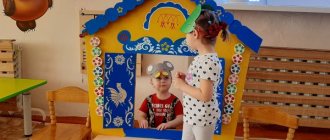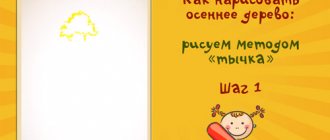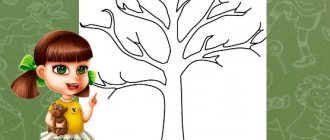Summary of logorhythmic lesson in the senior group
Logorhythmic lesson summary.
Topic: "Limpopo".
Objectives: 1. Generalization and systematization of knowledge about animals of hot countries, tropical plants, fruits and fruits. Clarification, activation and updating of the dictionary. 2. Development of coherent speech and communication skills, auditory attention and sense of rhythm, development of improvisational movements and the ability to act by demonstration, development of general and manual motor skills. 3. Fostering activity, initiative, independence of speech, the ability to act according to the rules and interact with group members. Equipment: claves, bells, CD player and CD recordings of musical accompaniment, massage balls, lion cub toy, ball. Progress of the lesson: 1. Greeting. Creating an emotional background for the lesson, an atmosphere of friendliness, and a mood for work. Children and parents stand in a circle and hold hands. They move in a circle. We will hold hands (2 times), smile at each other and say “Hello!” to everyone together.
Teacher: Children, we received a letter from Africa.
Let's read it. “The animals invite us to visit Africa!” What animals live in Africa? (children's answers)
How do we get there?
(children's answers)
Teacher: Today we will sail on a ship.
E. Zheleznova “Boat” We, brothers, draw with our fingers on our palms.
It’s so difficult to get to Africa!
We will go by car, Imitate steering wheel control
, And we will rush by train,
The movement of train wheels
We will fly in an airplane,
with our arms to the sides like wings
.
We show binoculars
On a ship on the ocean
Hands like a boat
Let's sail with the brave Captain.
The land is visible ahead. Place your palm on your forehead.
We've sailed to Africa, friends!
Let's clap our hands.
So we sailed to Africa!
Look who's greeting us!? Lion cub! Let's play with him! Finger gymnastics. “In hot countries...” (N. Nishcheva) Development of manual motor skills, coordination of movements, correlation of text and movements. (Children perform finger gymnastics).
-In hot countries
(Use light, sliding movements of all fingers across the table).
Rhinoceroses
(Place your hands on bent, outstretched fingers).
They just walk along the road.
(Move forward with your hands)
Hippos get wet in the river.
(Turn your hands over, palms up, clench and unclench your fingers.)
Lions go hunting.
(Fan out your fingers).
Crocodiles,
(Open your hands joined at the wrists).
Monkeys,
(Put your hands to your head, show your “ears”).
Zebras are inhabitants of the savannah.
(Interlace the fingers of both hands with each other, perform “jumping” movements forward along the table).
And tropical birds (
Interlace the thumbs of both hands with each other and flap your palms like wings).
There is something to marvel at here.
(Turn the palms of both hands lying on the table up and down).
Teacher: - What fruits grow in tropical countries?
Children answer: - Bananas, coconuts, oranges... Exercise “We divided the orange.” Play massage (method of early musical development by Ekaterina and Sergei Zheleznov).
Development of general motor skills.
We shared an orange, We shared an orange, We shared an orange, But there are many of us, and he is one. (Children roll massage balls between their palms).
This slice is for ducklings,
(Hands with massage balls are directed to the left).
This slice is for kittens,
(Hands with massage balls are directed to the right).
This slice is for the snake, And this slice is for the hedgehog,
(Hands with massage balls are directed forward).
This slice is for the beaver,
(Hands with massage balls - bottom right).
And for the wolf - the peel.
(Hands with massage balls - bottom left).
He is angry with us - trouble.
Everyone run away in all directions. (Hands roll massage balls behind back). Exercise "At Giraffes". Play massage (method of early musical development by Ekaterina and Sergei Zheleznov).
Development of general motor skills.
Children stand in a circle. The teacher turns on the musical accompaniment. Giraffes have spots, spots, spots, spots everywhere. Giraffes have spots, spots, spots, spots everywhere. (Pat themselves).
On the forehead, ears, neck, elbows, nose, belly, knees and socks.
(Show body parts).
Elephants have folds, folds, folds, folds everywhere, Elephants have folds, folds, folds, folds everywhere,
(Pinch themselves).
On the forehead, ears, neck, elbows, nose, belly, knees and socks.
(Show body parts).
Kittens have fur, fur, fur, fur everywhere.
Kittens have fur, fur, fur, fur everywhere. (Make shaking movements).
On the forehead, ears, neck, elbows, nose, belly, knees and socks.
(Show body parts).
And the zebra has stripes, there are stripes everywhere, And the zebra has stripes, there are stripes everywhere.
(Show stripes).
On the forehead, ears, neck, elbows, nose, belly, knees and socks.
(Show body parts).
Teacher: - What birds live in tropical countries?
Children: - Parrots, toucans... Teacher: - Let us show you an exercise about a parrot. Exercise “Green Parrot Jacques...” Development of improvisational movements and the ability to act by demonstration. -Green parrot Jacques. (Children step from foot to foot, arms pressed to the body, hands protruding to the sides).
-Wears a jacket with tails.
(Children perform stroking movements on the thighs)
-Wears a yellow shirt-front
(Children perform patting movements on the chest).
-And green pants.
(Children perform patting movements on their legs.)
-He flies
(Children wave their arms).
-He is chatting,
(Bring their palms to their mouth and remove them).
-He reads,
(palms open like a book),
-And he counts.
(Children bend their fingers one by one.)
- Listens carefully,
(Bring your palms to your ears and remove them).
-Speaks diligently.
(Bring your palms to your mouth and remove them.) Tongue Twister The parrot says to the parrot: “I’ll parrot you!” The parrot answers him: “Parrot, parrot, parrot!” Exercise "Palm Tree". Development of general motor skills and the ability to coordinate your movements with music. (Methodology of early musical development by S. and E. Zheleznov):
(Children stand in a circle at arm’s length from each other. The teacher turns on the musical accompaniment): -The wind is blowing, blowing out, a palm tree is shaking in the wind, -The wind is blowing, blowing out, a palm tree swings in the wind,
(Children raise their arms up and sway from side to side).
-And under the palm tree the crab sits and moves its claws.
-And under the palm tree the crab sits and moves its claws. (Children squat down and perform forward circular rotations with their hands.)
-A seagull flies over the water and dives for fish, -A seagull flies over the water and dives for fish,
(Children run in a circle and wave their arms).
-And under the palm tree the crab sits and moves its claws.
-And under the palm tree the crab sits and moves its claws. (Children squat down and perform forward circular rotations with their hands.)
-Under water at depth, a crocodile lies at the bottom, -Under water at depth, a crocodile lies at the bottom.
(Children stand in a circle, arms extended in front of them, one on top of the other. Arms spread and brought together).
-And under the palm tree the crab sits and moves its claws.
-And under the palm tree the crab sits and moves its claws. (Children squat down and perform forward circular rotations with their hands.)
Teacher: Let's see what kind of monkeys live in Africa.
Exercise “Monkeys” 10 monkeys swung on the vines and teased the crocodile: (swing your hands to the sides)
“If you don’t catch it, you won’t catch it”
(hands to your ears, make movements back and forth)
And a toothy crocodile swam out of the Nile River
(hands together, wave-like movements)
And gobbled up (…..) the monkeys.
(moves your fingers like the mouth of a crocodile) (Continue the text from the beginning, but with fewer monkeys). Exercise "Limpopo". (Children stand in a circle at arm's length from each other. The teacher turns on the musical accompaniment):
-This is how monkeys hang on a branch in Limpopo.
-This is how monkeys hang on a branch in Limpopo. (Children raise their arms up and lower them to shoulder level.)
-Limpopo, Limpopo, Limpopo, Limpopo,
(Children with their arms bent at the elbows turn to the left to the music).
-Limpopo, Limpopo, Limpopo, Limpopo,
(Children with their arms bent at the elbows turn to the right to the music).
-This is how monkeys in Limpopo eat bananas.
-This is how monkeys in Limpopo eat bananas. (Children take turns bringing their arms bent at the elbows to their mouths)
.
-Limpopo, Limpopo, Limpopo, Limpopo, (Children with their arms bent at the elbows turn to the left to the music)
.
-Limpopo, Limpopo, Limpopo, Limpopo, (Children with their arms bent at the elbows turn to the right to the music).
-This is how monkeys in Limpopo clean shoes.
-This is how monkeys in Limpopo clean shoes. (Children bend over and wave their arms with a small amplitude near their feet.)
-Limpopo, Limpopo, Limpopo, Limpopo,
(Children with their arms bent at the elbows turn to the left to the music).
-Limpopo, Limpopo, Limpopo, Limpopo,
(Children with their arms bent at the elbows turn to the right to the music).
-This is how the monkeys wash their pants in Limpopo, -This is how the monkeys wash their pants in Limpopo,
(Children bend forward and unbend, alternately bend and straighten their arms at the elbows).
-Limpopo, Limpopo, Limpopo, Limpopo,
(Children with their arms bent at the elbows turn to the left to the music).
-Limpopo, Limpopo, Limpopo, Limpopo.
(Children with their arms bent at the elbows turn to the right to the music).
-This is how monkeys sweep the floor in Limpopo, -This is how monkeys sweep the floor in Limpopo,
(Children wave their hands in front of them).
-Limpopo, Limpopo, Limpopo, Limpopo,
(Children with arms bent at the elbows turn to the left to the music).
-Limpopo, Limpopo, Limpopo, Limpopo.
(Children with their arms bent at the elbows turn to the right to the music).
-This is how monkeys dance together in Limpopo. -This is how monkeys dance together in Limpopo.
(Children perform improvised dance movements.)
-Limpopo, Limpopo, Limpopo, Limpopo,
(Children with arms bent at the elbows turn to the left to the music).
-Limpopo, Limpopo, Limpopo, Limpopo.
(Children with their arms bent at the elbows turn to the right to the music).
Teacher: Look what the Lion Cub brought us!
Sticks are claves. Shall we play? Exercise “Hippopotamus” Hippopotamus, close your mouth. 2 hits with each stick
you scare people.
Knock with chopsticks against each other
I honestly admit to you,
Knock with chopsticks at the same time
I smile at you!
Make a smile out of sticks.
-We had a fun time, and now we need to go back, we board the ship
(Children sit on the chairs). E Zheleznova “Boat” Summing up the lesson. Updating knowledge. Development of coherent speech. Completion. Ritual of farewell. “Well, everyone stood in a circle.” Well, everyone stood in a circle, everyone suddenly held hands.
We studied for a whole hour, And fooled around a little, And now kids, it’s time for everyone to go home! Application
Mysteries of deception. 1. He lives among the swamps, he has a big belly and a huge scary mouth! It's a fat hippo! 2. Clumsy eats sedge in the Nile River ... (hippopotamus) 3. Thick-skinned ..... (elephant) takes hay with his trunk. 4. The sun’s ray has gone out over the forest, the king of beasts is sneaking... (lion). 5. You won’t find a longer neck, It will tear off any branch... (giraffe). 6. who will fly up from the flower here? Multi-colored...(hippopotamus)! Butterfly. 7. On the fence in the morning...a kangaroo (rooster) crowed. 8. Chik - chirp! Chick - tweet! - Who raised a cheerful cry? Don't scare this bird! The parrot (sparrow) became noisy. 9. Dur - cancer! - shouts from the cage. Don't be afraid! The strange bird is called .... Sparrow (parrot). 10. A cow (monkey) deftly jumps from the palm tree down onto the palm tree again. 11. The fastest one rushes out of fear….the turtle (hare). 12. A shaggy, clubfooted......crocodile (bear) passed by the hive 13. In winter, a shaggy, clubfooted......elephant (bear) dreams in a den.
We recommend watching:
Script of the play for kindergarten. Senior group Summer fun for kindergarten. Senior preparatory group Methodological development of a summer entertainment scenario for children of the middle group Literary quiz with answers on Russian folk tales for children of the middle group.
Similar articles:
Developmental lesson in the senior group of preschool educational institutions
Drawing lesson for senior group
Summary of educational activities in the senior speech therapy group on the topic “Construction”
Summary of joint activities of the teacher and children of the senior speech therapy group on the development of fine motor skills of the hands
Notes on the formation of elementary mathematical concepts in the senior group for children with mental retardation
Summary of a logorhythmic lesson for children of senior preschool age “A Home for Everyone”
Goal: overcoming speech disorders through the development, education and correction of the motor sphere in children in combination with words and music.
Tasks.
Educational:
• develop in children a sense of rhythm, the ability to switch from one type of movement to another; • strengthen children's skills to accurately perform movements in accordance with the text; • form the correct articulation and clear pronunciation of words when singing songs, learn to convey the playful nature of the song, and take the breath correctly while singing; • develop in children the ability to navigate in space, to clearly and correctly perform walking, running, hopping, and jumping when given a signal.
Correctional and developmental:
• development of speech motor skills for the formation of an articulatory base of sounds, physiological and phonation breathing; • development of auditory attention and phonemic hearing; • development of general and fine motor skills, kinesthetic sensations, facial expressions, spatial organization of movements; • develop the ability to influence biologically active points to prevent colds; • training in the simplest massage techniques.
Educational:
• fostering goodwill and mutual assistance; • develop the ability to perform collective actions: move, sing together; • cultivate a caring attitude towards the environment. Equipment: presentation on the topic in PowerPoint, tape recorder, music CDs, balloon, drum, wolf hat.
Senior group. Senior preschool age. Children 5-6 years old
Notes for a logorhythmics lesson in a senior speech therapy group “Hello, autumn, hello, forest full of fairy tales and miracles.” Notes for a logorhythmics lesson in a senior speech therapy group . Topic: “Hello, autumn, hello, forest full of fairy tales and miracles!”
Objectives: 1. Development of spatial orientation. 2. Development of coordination of speech with movement. 3. Development and activation of attention. 4. Development...
Summary of a logorhythmic lesson in a senior group with children with a speech disorder “Journey to the land of sounds and letters” Logorhythmic lesson in a senior group with children with a speech disorder. Journey to the land of sounds and letters. Integration of educational areas: “Speech development”
,
“Social and communicative development”
,
“Cognitive development”
,
“Artistic and aesthetic development”
,
“Physical development”
...






